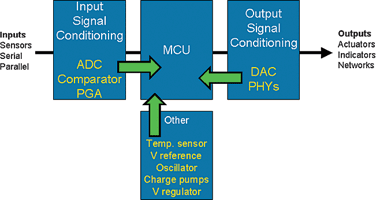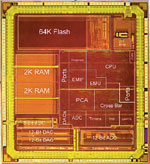
Historically, the minimum requirement of a mixed-signal microcontroller (MCU) was support for analog-to-digital converters (ADCs) and/or digital-to-analog converters (DACs) on a single IC. However, designers should expect more from a device called 'mixed-signal.'
A truly mixed-signal MCU is a system-on-a-chip that is able to handle both analog and digital inputs and outputs without sacrificing performance when compared to a discretely implemented solution. While few offerings deliver full-featured mixed-signal MCUs, those that do, offer a host of advantages over traditional solutions.
Reducing the 'Bill-of-Materials'
Mixed-signal MCUs simplify partitioning problems because they are capable of handling different types of signals on the same chip. The integration inherent in a mixed-signal MCU simplifies the design while reducing the board real estate required.
In the design process, once the system specification has been defined and the implementation partitioning options have been determined, a decision must be made on how to optimise the system based on design constraints such as maximising performance, power consumption, physical space constraints, overall system cost, etc. There are an infinite number of different products for the designer to choose from - sensors, actuators, and discrete analog components such as transistors/diodes/capacitors, analog chips such as power supplies and amplifiers, digital chips such as programmable logic chips, fixed function controllers, memory chips, microprocessors and MCUs.
A typical constraint is enabling multiple types of signals required in the system while minimising board space and system complexity. For example, a sensor may provide a very small analog signal in the mV range. Programmable processors use digital signals that are usually in the 1,8-5,5 V range. System-controlled actuators will likely need a power stage with higher voltages and currents that are analog in nature. Because there is a wide variety in the types of signals that are used in most electronic systems, the partitioning problem is complex.
Using a typical embedded system as an example (see Figure 1); sensors provide analog signal inputs that need to be conditioned by a combination of ADCs, comparators and programmable gain amplifiers (PGAs) before they can be processed by an MCU. The MCU outputs are typically digital and need to be reconditioned back to analog by DACs or physical layer chips (PHYs) before they can be used to drive analog components. The remaining functions in an embedded system are housekeeping functions that are usually analog in nature - temperature sensor, voltage references, oscillator, charge pumps (required for supplying the higher voltage needed for programming flash EEPROM) and voltage regulators.

Many of the functions described, including all of the typical analog functions usually implemented in discrete analog chips, can be integrated onto a single MCU; this is the essence of a mixed-signal MCU.
Figure 2 compares a typical MCU with a number of discrete analog components - programmable gain amp (PGA), ADCs, DACs, comparators (CMP), crystal oscillator (XTAL), reference voltage (REF), resistors and capacitors - and a mixed-signal MCU that provides all of these functions in a single system-on-a-chip. The size of the circuit is reduced, which is very important in many applications. In fact, it is often the number one consideration in applications that are required to be 'wearable' such as portable MP3 players.

Reliability is another benefit of a more integrated solution. The main source of reliability problems in embedded systems is interconnections - solder joints and mechanical connections. The more interconnections that exist, the more failures can be expected. Mixed-signal MCUs reduce components and interconnections and therefore markedly increase system reliability.
Lower power, noise and cost
Reduced power consumption is another advantage that a single chip mixed-signal MCU provides. The advantage of the lowest power MCU on the market is lost if it needs to be used in a system with a power-hogging standalone ADC or other power-hungry analog chips. Because mixed-signal MCUs have the power supply overhead requirements of only one chip, they have a lower power budget than a system that uses several components.
The noise performance of the system for both noise emissions and susceptibility will be better for a mixed-signal MCU-based system than a system that has separate analog and digital chips. There are no high-speed digital signals connected to standalone ADCs and DACs so emissions are lower. Overall system susceptibility to noise is also improved because there is a reduction in the number of system components that can be affected.
A highly integrated system lowers overall system cost. The reduction in components and the economies of single package, die and test costs are an important advantage of the integrated mixed-signal MCU solution. There are other cost savings as well - the software and overall design are less complex. This translates to reduced development time, lower development cost and faster time-to-market.
The challenge: Design complexity
Digital and analog chips have traditionally used different types of manufacturing process technology. The 'workhorse' process for digital ICs such as MCUs and memory chips is complementary metal oxide semiconductor (CMOS). CMOS is commonly used for digital-only chips while analog ICs usually use different process technologies such as BiCMOS and Bipolar. Because CMOS is the lowest-cost process in the industry, the objective of mixed-signal ICs is to couple both analog and digital circuits on a monolithic chip using industry-standard CMOS process technology. This IC design challenge requires specialised knowledge and skill. There are significantly fewer engineers in the industry proficient in analog design than digital design. There are also no standardised design tools for mixed-signal ICs.
In addition, the performance of analog functions in many MCUs is degraded in the presence of the high-speed digital bus. To achieve the goal of replacing multiple chips in the system, a truly mixed-signal MCU should have an on-chip 12-bit ADC, on-chip DAC and oscillator at minimum.
It is a significant challenge to develop and manufacture mixed-signal MCUs, and technical problems that are encountered are significant. For example, it takes a skillful designer to ensure that digital noise does not degrade the performance of analog peripherals. It is difficult to develop and produce mixed-signal MCUs, but the advantages they offer are significant. By integrating high-precision, high-speed analog peripherals with digital control circuits on the same chip, a mixed-signal MCU allows designers to bypass system level analog-digital integration issues.
Looking closely at a mixed-signal MCU as defined here (Figure 3), the analog circuits on the chip are visibly less 'regular' than the digital circuits. The RAM and Flash arrays are regular structures (except for the charge pump circuits on the right side of the 64K Flash block). The two 12-bit DAC blocks, the 8-bit ADC block and the 12-bit ADC block are clearly more handcrafted architectures than the sea-of-gates structure of the digital functions (CPU, ports, timers, UARTs, etc). Other analog functions included on this chip are an on-chip oscillator that replaces an external crystal or resonator, on-chip temperature sensor and a pair of comparators with programmable hysteresis that can be used for wake-ups or interrupts.

The availability of a mixed-signal MCU that meets the specifications on the data sheet gives design engineers a host of new options in the architecture of their system design. Ideal for applications such as industrial and process feedback control systems, cellular base stations, portable and stationary test equipment, smart transmitters and weigh scales, mixed-signal MCUs offer designers an affordable alternative for smaller, faster MCUs with better analog.
For more information contact NuVision Electronics, +27 (0)11 894 8214, [email protected]

© Technews Publishing (Pty) Ltd | All Rights Reserved